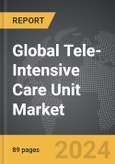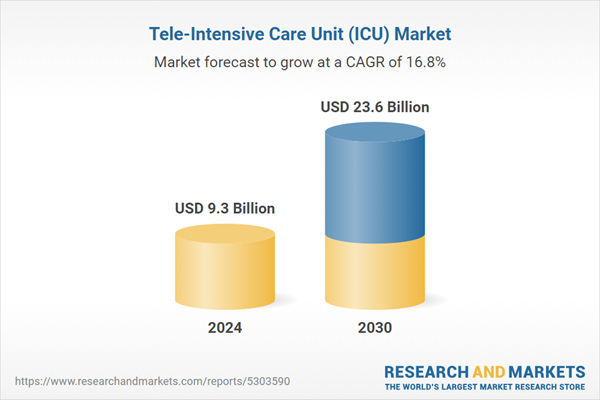The global market for Tele-Intensive Care Unit (ICU) was valued at US$9.3 Billion in 2024 and is projected to reach US$23.6 Billion by 2030, growing at a CAGR of 16.8% from 2024 to 2030. This comprehensive report provides an in-depth analysis of market trends, drivers, and forecasts, helping you make informed business decisions. The report includes the most recent global tariff developments and how they impact the Tele-Intensive Care Unit (ICU) market.
Segments: Component (Hardware, Software); Type (Open with Consultants, Intensivist, Open, Co-managed).
Geographic Regions/Countries: World; United States; Canada; Japan; China; Europe (France; Germany; Italy; United Kingdom; and Rest of Europe); Asia-Pacific; Rest of World.
The analysts continuously track trade developments worldwide, drawing insights from leading global economists and over 200 industry and policy institutions, including think tanks, trade organizations, and national economic advisory bodies. This intelligence is integrated into forecasting models to provide timely, data-driven analysis of emerging risks and opportunities.
Global Tele-Intensive Care Unit (ICU) Market - Key Trends and Drivers Summarized
How Is the Tele-Intensive Care Unit (ICU) Improving Critical Care?
The Tele-Intensive Care Unit (Tele-ICU) is an innovative healthcare service that enables remote monitoring and management of critically ill patients through real-time data exchange and communication. It connects bedside ICU teams with remote critical care specialists via telemedicine, providing continuous patient monitoring, clinical decision support, and timely interventions. Tele-ICUs play a crucial role in enhancing critical care, improving patient outcomes, and optimizing resource utilization, especially in hospitals facing shortages of ICU staff or specialists. As healthcare facilities prioritize advanced solutions for critical care, Tele-ICUs have emerged as a key component in modern healthcare delivery.What Are the Key Segments in the Tele-ICU Market?
Key components include hardware, software, and services, with software holding the largest market share due to its role in enabling real-time data exchange, patient monitoring, and decision support. Types include centralized models, decentralized models, and hybrid models, with the centralized model leading the market driven by its effectiveness in remote monitoring and rapid intervention. End-users include hospitals, specialty centers, and government facilities, with hospitals dominating the segment as they integrate Tele-ICU systems to enhance patient care, reduce ICU mortality rates, and manage critical care remotely.How Is the Tele-ICU Integrated Across Critical Care Facilities?
In hospitals, Tele-ICUs facilitate 24/7 monitoring of critical patients, enabling timely interventions based on continuous assessment of vital signs, lab results, and clinical status. For rural hospitals and specialty centers with limited ICU staff, Tele-ICUs provide access to specialist consultations, enhancing the quality of care for critically ill patients. In government facilities, Tele-ICUs support the management of public health emergencies and disaster response by providing remote critical care monitoring, improving patient outcomes during pandemics and large-scale health crises. Additionally, hybrid Tele-ICU models combine on-site care with remote expertise, optimizing ICU operations and improving care quality across healthcare networks.What Factors Are Driving the Growth in the Tele-ICU Market?
The growth in the Tele-ICU market is driven by several factors, including increasing demand for critical care solutions, advancements in telemedicine technology, and rising investments in healthcare infrastructure. Innovations like AI-driven predictive analytics, advanced remote monitoring tools, and seamless integration with electronic medical records (EMRs) have supported broader adoption in critical care facilities. The focus on reducing ICU mortality rates, optimizing staff resources, and managing patient loads effectively has further fueled demand, as Tele-ICUs provide comprehensive solutions for critical care management. Additionally, expanding healthcare access, improving patient outcomes, and the need for pandemic preparedness have contributed to market growth, encouraging the deployment of Tele-ICU systems in hospitals and healthcare facilities worldwide.Report Scope
The report analyzes the Tele-Intensive Care Unit (ICU) market, presented in terms of units. The analysis covers the key segments and geographic regions outlined below.Segments: Component (Hardware, Software); Type (Open with Consultants, Intensivist, Open, Co-managed).
Geographic Regions/Countries: World; United States; Canada; Japan; China; Europe (France; Germany; Italy; United Kingdom; and Rest of Europe); Asia-Pacific; Rest of World.
Key Insights:
- Market Growth: Understand the significant growth trajectory of the Hardware segment, which is expected to reach US$17.1 Billion by 2030 with a CAGR of a 14.9%. The Software segment is also set to grow at 23.1% CAGR over the analysis period.
- Regional Analysis: Gain insights into the U.S. market, valued at $2.6 Billion in 2024, and China, forecasted to grow at an impressive 16.0% CAGR to reach $3.6 Billion by 2030. Discover growth trends in other key regions, including Japan, Canada, Germany, and the Asia-Pacific.
Why You Should Buy This Report:
- Detailed Market Analysis: Access a thorough analysis of the Global Tele-Intensive Care Unit (ICU) Market, covering all major geographic regions and market segments.
- Competitive Insights: Get an overview of the competitive landscape, including the market presence of major players across different geographies.
- Future Trends and Drivers: Understand the key trends and drivers shaping the future of the Global Tele-Intensive Care Unit (ICU) Market.
- Actionable Insights: Benefit from actionable insights that can help you identify new revenue opportunities and make strategic business decisions.
Key Questions Answered:
- How is the Global Tele-Intensive Care Unit (ICU) Market expected to evolve by 2030?
- What are the main drivers and restraints affecting the market?
- Which market segments will grow the most over the forecast period?
- How will market shares for different regions and segments change by 2030?
- Who are the leading players in the market, and what are their prospects?
Report Features:
- Comprehensive Market Data: Independent analysis of annual sales and market forecasts in US$ Million from 2024 to 2030.
- In-Depth Regional Analysis: Detailed insights into key markets, including the U.S., China, Japan, Canada, Europe, Asia-Pacific, Latin America, Middle East, and Africa.
- Company Profiles: Coverage of players such as Advanced ICU Care, Apollo Tele Health Services, Banner Health, CEIBA-TELEICU, Cloudbreak Health and more.
- Complimentary Updates: Receive free report updates for one year to keep you informed of the latest market developments.
Some of the 33 companies featured in this Tele-Intensive Care Unit (ICU) market report include:
- Advanced ICU Care
- Apollo Tele Health Services
- Banner Health
- CEIBA-TELEICU
- Cloudbreak Health
- Eagle Telemedicine
- iMDsoft
- Inova
- InteleICU
- InTouch Technologies, Inc.
- InTouchhealth
- Koninklijke Philips N.V.
- SOC Telemed
- TeleICU
- UPMC Italy
- VISICU
Tariff Impact Analysis: Key Insights for 2025
Global tariff negotiations across 180+ countries are reshaping supply chains, costs, and competitiveness. This report reflects the latest developments as of April 2025 and incorporates forward-looking insights into the market outlook.The analysts continuously track trade developments worldwide, drawing insights from leading global economists and over 200 industry and policy institutions, including think tanks, trade organizations, and national economic advisory bodies. This intelligence is integrated into forecasting models to provide timely, data-driven analysis of emerging risks and opportunities.
What’s Included in This Edition:
- Tariff-adjusted market forecasts by region and segment
- Analysis of cost and supply chain implications by sourcing and trade exposure
- Strategic insights into geographic shifts
Buyers receive a free July 2025 update with:
- Finalized tariff impacts and new trade agreement effects
- Updated projections reflecting global sourcing and cost shifts
- Expanded country-specific coverage across the industry
Table of Contents
I. METHODOLOGYII. EXECUTIVE SUMMARY2. FOCUS ON SELECT PLAYERSIII. MARKET ANALYSISIV. COMPETITION
1. MARKET OVERVIEW
3. MARKET TRENDS & DRIVERS
4. GLOBAL MARKET PERSPECTIVE
UNITED STATES
CANADA
JAPAN
CHINA
EUROPE
FRANCE
GERMANY
ITALY
UNITED KINGDOM
REST OF EUROPE
ASIA-PACIFIC
REST OF WORLD
Companies Mentioned (Partial List)
A selection of companies mentioned in this report includes, but is not limited to:
- Advanced ICU Care
- Apollo Tele Health Services
- Banner Health
- CEIBA-TELEICU
- Cloudbreak Health
- Eagle Telemedicine
- iMDsoft
- Inova
- InteleICU
- InTouch Technologies, Inc.
- InTouchhealth
- Koninklijke Philips N.V.
- SOC Telemed
- TeleICU
- UPMC Italy
- VISICU
Table Information
| Report Attribute | Details |
|---|---|
| No. of Pages | 89 |
| Published | April 2025 |
| Forecast Period | 2024 - 2030 |
| Estimated Market Value ( USD | $ 9.3 Billion |
| Forecasted Market Value ( USD | $ 23.6 Billion |
| Compound Annual Growth Rate | 16.8% |
| Regions Covered | Global |









